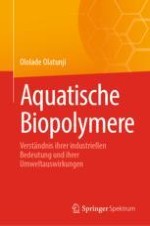2024 | OriginalPaper | Buchkapitel
15. Polyester
verfasst von : Ololade Olatunji
Erschienen in: Aquatische Biopolymere
Aktivieren Sie unsere intelligente Suche, um passende Fachinhalte oder Patente zu finden.
Wählen Sie Textabschnitte aus um mit Künstlicher Intelligenz passenden Patente zu finden. powered by
Markieren Sie Textabschnitte, um KI-gestützt weitere passende Inhalte zu finden. powered by
